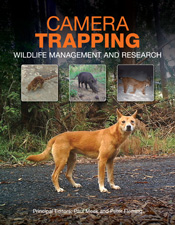Preface
pp. vii-viii
PDF (54 KB)
Preface
pp. vii-viii
PDF (54 KB)Acknowledgements
pp. ix
PDF (39 KB)Introduction
pp. x-xii
PDF (94 KB)Contributors
pp. xiii-xx
PDF (111 KB)1 Camera trapping for animal monitoring and management: a review of applications
pp. 3-11
2 Camera trap monitoring for inventory and management effectiveness in Victorian national parks: tailoring approaches to suit specific questions
pp. 13-26
3 Sentinel camera traps monitor the emergence of infectious disease in Tasmanian devils (Sarcophilus harrisii)
pp. 27-33
4 What can camera traps tell us about the diurnal activity of the nocturnal bare-nosed wombat (Vombatus ursinus)?
pp. 35-43
5 The Wildlife Picture Index: monitoring Mongolian biodiversity with camera trapping
pp. 45-52
6 Examining the state of biodiversity using camera traps in the Pacaya Samiria National Reserve, Peru
pp. 53-60
7 Population estimates of an endangered rock-wallaby (Petrogale penicillata) using time-lapse photography from camera traps
pp. 61-68
8 Fauna survey by camera trapping in the Torricelli Mountain Range, Papua New Guinea
pp. 69-76
9 Monitoring malleefowls with camera traps in Western Australia’s Wheatbelt: a case study in citizen science
pp. 77-86
10 Wildlife camera trapping in the Himalayan kingdom of Bhutan with recommendations for the future
pp. 87-98
11 A review of the ultimate camera trap for wildlife research and monitoring
pp. 101-109
12 The effect of camera trap type on the probability of detecting different size classes of Australian mammals
pp. 111-121
13 Comparing the effectiveness of two types of camera trap for surveying ground-dwelling mammals
pp. 123-130
14 Using camera traps to compare poison bait uptake by invasive predators and non-target species
pp. 131-139
15 Can camera trap surveys provide reliable population estimates for nondescript species?
pp. 173-179
16 More than just presence–absence: camera traps reveal fine scale resource partitioning by the ubiquitous swamp wallaby (Wallabia bicolor)
pp. 181-188
17 Camera traps, sand plots and known events: what do camera traps miss?
pp. 189-202
18 How long is a piece of string? Camera trapping methodology is question dependent
pp. 205-214
19 A novel camera-based approach to understanding the foraging behaviour of mycophagous mammals
pp. 215-224
20 Using camera traps to survey diurnal terrestrial reptiles: a proof of concept
pp. 225-232
21 The use of camera traps to detect arboreal mammals: lessons from targeted surveys for the cryptic Leadbeater’s possum (Gymnobelideus leadbeateri)
pp. 233-243
22 Using camera traps to monitor use of roadside glide poles and rope canopy-bridges by Australian gliding mammals
pp. 245-252
23 Comparison of camera trapping and live trapping of mammals in Tasmanian coastal woodland and heathland
pp. 253-262
24 TEAM: a standardised camera trap survey to monitor terrestrial vertebrate communities in tropical forests
pp. 263-270
25 Developing a camera trap survey protocol to detect a rare marsupial carnivore, the spotted-tailed quoll (Dasyurus maculatus)
pp. 271-279
26 Automatic camera trap data organisation, storage and analysis without entering data by hand using a keyboard
pp. 283-290
27 Assessing the power to detect change in red fox (Vulpes vulpes) occupancy using camera surveys in the Grampians National Park
pp. 291-298
28 Computer-assisted identification of small Australian mammals in camera trap imagery
pp. 299-306
29 Can camera traps be used to estimate small mammal population size?
pp. 307-316
30 Density estimation using camera trap surveys: the random encounter model
pp. 317-323
31 Analysis of camera trap surveys to detect effects of population management
pp. 325-330
32 Now we can ‘see the forest and the trees, too’, but there are risks: camera trapping and privacy law in Australia
pp. 331-345
33 Putting contemporary camera trapping in focus
pp. 349-356
Index
pp. 357-367
PDF (159 KB)